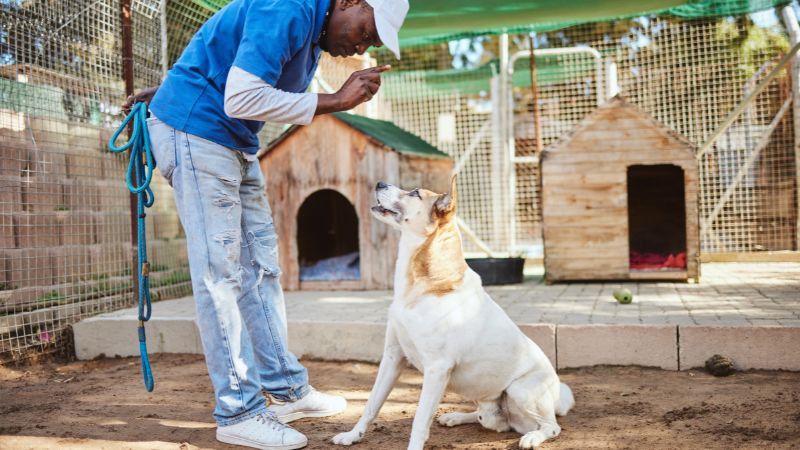
How To Craft A Cozy Cat Vest From Fabric Strips
Have you ever seen your feline friend lounging around and thought, “What could possibly make this picture more adorable?” The answer is simple: a cat

Hello everyone, this is Sophie. Let’s dive into ‘How to Teach Your Dog to Be Quiet on Command’ with comprehensive, step-by-step instructions.
Dogs bark, it’s a known thing. Often, people with dogs that bark a lot just ignore the noise. Dogs bark for various reasons. Some seek attention, others act protective. But, a constantly barking dog can be annoying.
Normally, dogs bark when they hear the doorbell or notice something unusual at home. This is their way of being protective. However, you can teach them to quiet down immediately on command.
Interestingly, the best method to make a dog quiet is to teach them to bark when you ask. It might seem strange at first, but after I explain and show how it’s done, it works wonderfully. Let’s explore how this is done…
Pick treats that your dog loves the most. It’s essential they’re a bit hungry for this to work best. You could even use part of their regular meal for this training. This will make them more eager to follow your commands in exchange for something they really want.
As I always emphasize, the key to successful training is: Control, Train, and Treat. Control is crucial. Using a dog harness is one of the easiest and most effective ways to maintain this control. When you start this training session, keep the dog harness in your hand. This helps you manage your dog’s movements and keeps them focused on the task at hand, making the training process smoother for both of you.
Read full articles about teaching your dog to bark on your command.
This part is about teaching your dog to bark on a specific command, which we’ll call “Speak”. This is usually not too hard, especially with dogs that tend to bark a lot. The trick is to find what naturally makes them bark. Common triggers are a knock or a doorbell. Let’s break down how to do this:
Go to your door and slightly open it, just enough for you to reach the doorbell or to knock. Ring the bell or knock, and your dog will likely start barking. Stand between your dog and the door. At this moment, issue the “Speak” command along with a unique hand gesture, like moving your index finger side to side. When your dog barks, give them a treat. However, avoid praising them; we want them to associate the treat with the command, not just bark.
You’ll need to repeat the above steps multiple times for the next few hours. This repetition is crucial to firmly establish the “Speak” command in your dog’s mind. By doing this, you’re turning a natural habit into a structured behavior. You’re changing the rules of their game to align with your training goals.
Continue practicing this technique until your dog consistently responds to both your verbal command and hand signal. This consistency is key to ensuring they understand and follow the command every time.
Your dog should now respond to the “Speak” command instantly, without needing a doorbell or knock. Most dogs get this in about an hour. Some learn faster, and others may take longer.
Give the “Speak” command with your hand signal. As your dog starts barking, now say “Quiet”. Don’t shout, just say it firmly. You’ve trained them to bark on cue, so this bark is under control.
If they keep barking, just wait until they stop. They’ll stop faster with the “Speak” command you trained. Once they stop barking, please wait a bit then reward them. This pause teaches them they get treats for quiet, not barking. Try extending the quiet time each day before giving a treat. Aim for 10-15 seconds of silence within a week.
This solidifies the command in their memory. The more you practice, the better they get at staying quiet. They might bark when the doorbell rings, but now you have a command to stop that. It’s a bit harder with a doorbell, but still helps a lot, reducing the issue by at least 80%. Some dogs, deeply set in their ways, might take longer, but patience is key in training.
Remember, patience is key in dog training. Keep calm, be consistent, and gradually your dog will learn. Try these tips with your dog and see how they progress. I hope this article helps you understand how to teach your dog to be quiet on command. Let me know how it goes!


Have you ever seen your feline friend lounging around and thought, “What could possibly make this picture more adorable?” The answer is simple: a cat

The moment you consider a dog hunting vest for your adventurous companion, you’re stepping into a world where safety meets functionality. This vest is not

The concept of a dog cooling vest is a game-changer for pet owners looking to enhance their dog’s comfort during those relentless summer days. Imagine

When you first consider crafting a tactical dog vest, it’s not just about embarking on a fun DIY project; it’s about ensuring your furry companion’s

Have you ever seen your feline friend lounging around and thought, “What could possibly make this picture more adorable?” The answer is simple: a cat

The moment you consider a dog hunting vest for your adventurous companion, you’re stepping into a world where safety meets functionality. This vest is not

The concept of a dog cooling vest is a game-changer for pet owners looking to enhance their dog’s comfort during those relentless summer days. Imagine

When you first consider crafting a tactical dog vest, it’s not just about embarking on a fun DIY project; it’s about ensuring your furry companion’s
Secure and Empower, Walk Responsibly
Copyright © 2024pettacticalharness. All Rights Reserved.